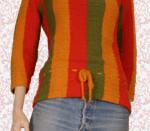"Eleven"� In the story "Eleven,"� Sandra Cisneros uses the literary techniques of perspective and diction to characterize Rachel as a bewildered little girl who is trying to act anything but her own age. Because of Cisneros' successful use of varied literary techniques, "Eleven"� achieves much more then is present at first glance.
Rachel's point of view as an eleven year old girl is crucial to understanding the idea that the author is trying to depict. When Rachel is told the sweater is hers, she blames the entire incident on her age, instead of the real problem, her immaturity. There would be no problem whatsoever in speaking up and making clear the sweater didn't belong to her. However, she gets angry and frustrated, telling herself that if she were only a little older, the problem would not even be a moot topic. Instead of giving the sweater back to Mrs.
Price, she shamefully puts it on and blames the entire incident on her age, using that as an excuse. Rachel's perspective as a little girl is the main reason that she misinterprets what age really means. Rachel thinks that it is only acceptable to do some things at a certain age. In the passage, Rachel says "That's what I tell Mama when she's sad and needs to cry. Maybe she's feeling three."� (Cisneros, 17) Again, her perspective comes into play. Although in some matters age is a factor in how people are supposed to act, Rachel goes too far by saying that at a certain age she must act a certain way.
Another literary technique Cisneros uses to her stories advantage is diction. Rachel talks in her own language applicable to her own world, the world of a wide eyed child seeing everything for the very first time. Because Cisneros...


